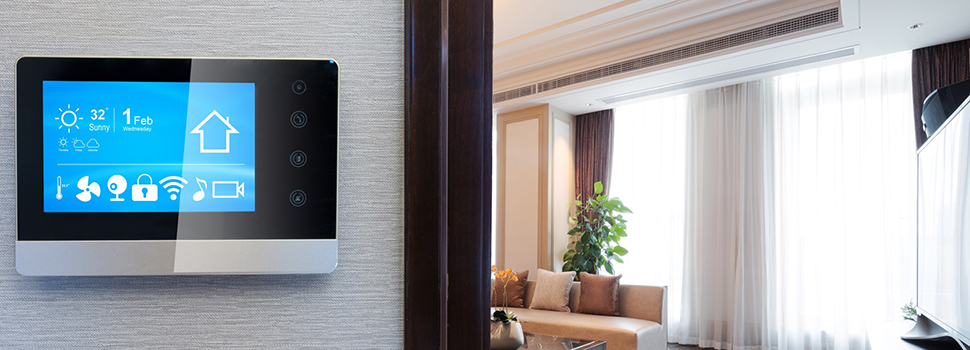Karen Quach | January 15, 2018
Living Smarter: New Tech Trends in Smart Homes
The smart home industry moves fast.
Smart homes represent the bleeding edge of technology and applied science for everyday living. Using high-tech devices and web-connected appliances, you can streamline everyday tasks, from watering the lawn to recording your favorite TV show.
A smart home is greener, more efficient, and more secure so you can focus your attention on the things that really matter.
Let your home do more of the heavy lifting with these ten exciting tech items.
1. Digital Assistants
Digital assistants are, without question, the biggest trend in smart home wizardry. Smartphones have had the technology for a few years with Apple’s Siri, Google’s Assistant, and Microsoft’s Cortana, but the technology has found its best home in yours.
A digital assistant with voice-recognition technology acts as the concertmaster for every other automated feature in your home, from lightbulbs to laundry machines. Amazon’s Echo and Echo Mini devices utilize the voice-activated digital assistant Alexa, which has over 15,000 unique skills, and can integrate with just about every one of your high-tech home’s electronic devices, which we discuss more below. The digital assistant market might be crowded, but Amazon’s Alexa is the reigning champion of smart home automation.
Additionally, voice-activated smart speakers like the Echo are an invaluable part of any smart home. These futuristic virtual assistants can check the weather, check for traffic on your commute, and play your favorite morning power tunes. Alexa is also a direct tie-in with Amazon, one of the web’s largest shopping services, making it easy to add laundry detergent to your next Prime package.
With integration options for smart outlets, lightbulbs, thermostats, home security systems, and more, Alexa is also your home’s virtual command station. Echo devices use a proximity system to respond to voice commands independently from anywhere in your home, provided there’s a unit within earshot.
The Amazon Echo isn’t the only option either—Google, Apple, and other tech giants all offer their own versions of connected devices.
2. Smart Lightbulbs
In the last decade, most homeowners have made the jump to energy-efficient lightbulbs.
LED bulbs with ten-year or longer lifespans were a gamble when they first appeared on the market, but the technology quickly became a success and the price of these bulbs lowered as their popularity rose. Wi-Fi–connected, automated lightbulbs piggybacked on the success of these premium bulbs and are now a staple of the smart home market.
Most smartbulbs allow you to sync up with your home’s lighting over Wi-Fi via a smartphone app, so you can control and monitor your lights even when you aren’t home. BeOn’s smart bulbs take this feature one step further with additional security measures. They’ll automatically turn on if your doorbell or alarm is triggered, and they’ll even replicate your lighting patterns when you’re on vacation to give the illusion of an occupied home. Smart lightbulbs are a must-have for the smart home owner, as they’re one of the easiest features to integrate with your phone or Echo device.
3. Robot Vacuums
The iRobot Roomba made a big splash when it was first introduced fifteen years ago, and the Roomba now has hundreds of imitators. Today, smart vacuums patrol most homes across the US. Since the introduction of the original Roomba, iRobot has been hard at work innovating new devices for the now-saturated market.
Like your smart home, the Roomba is getting wiser with every new generation, and as an innovator in the smart home market, iRobot is opening doors for the next generation of smart homes. The flagship Roomba collects both dirt and data as it completes its rounds across your living room carpet. The company’s newest bot is a home cartographer, building maps of your floor space and its current position. This feature lets your Roomba stop vacuuming, dock, charge, and start again right where it left off—an efficient feature most homeowners are sure to love.
iRobot’s map-building technology goes beyond picking up pet hair—these maps could be the next breakthrough in smart home automation. The suite of sensors and small cameras on Roomba’s best vacuums builds a network of data about your home—from your lighting schedule to your cooling and heating preferences—which could one day form the gray matter of your smart home’s brain. With this collection of mapped data, your lighting could adjust to the weather and time of day and your air conditioning could automatically adjust for natural airflow.
4. Smart Outlets
Smart outlets let you automate almost all your appliances straight from their power source. These innovative little plug-in devices range in size from small outlet adapters to full-size power strips, helping you set timers and schedules to all the appliances in your home. The newest generation of smart outlets improves on the form factor of their predecessors by plugging into an existing outlet without blocking off more than one socket. What’s more, these outlet adapters also let you control all your appliances from your smartphone.
The Belkin WeMo is a great introduction to smart-home automation. You can use it to schedule power for everything from desk fans to home entertainment systems. Timers and schedules set for these connected outlets can keep all your electronics off at night so that you’re not wasting electricity. These outlets help make your home more efficient, and they could pay for themselves with the money you save on your utility bill.
5. DVR Systems
Home entertainment systems have been the showcase of cutting-edge home technology for generations. Entertainment systems are sleeker, smarter, and more easily customized than systems of yesteryear. Automating your home’s entertainment system with a smart DVR lets you watch your favorite shows and movies on your own schedule from every room in your house.
A DVR is the center of the smart home entertainment universe, and new offerings from companies like DISH® are smarter than ever. DISH’s Hopper DVR lets you record up to six or sixteen shows at the same time, depending on which Hopper device you choose. The Hopper also integrates with DISH’s Joey receivers, which expand your DVRs reach to multiple TVs throughout your home and can let you enjoy your shows in 4K.
DISH also offers DISH Anywhere™, a streaming service that untethers your favorite TV. You can sync up to five devices with your Hopper library to view content offline or you can watch TV live right from your smartphone. The Hopper DVRs also sync up with Amazon Echo, so you can ask Alexa to record the latest episode of Grace and Frankie while you’re binge-watching Game of Thrones.
6. Smart Appliances
Large appliance manufacturers are jumping into the smart home market in droves. Nearly every manufacturer now offers web-connected appliances, including dishwashers, refrigerators, laundry machines, and heaters. Most of these appliances are compatible with digital assistants like Alexa, Google Home, Nest, and Dash.
With web-connected appliances, you can control everyday tasks like adjusting laundry cycles or setting cooking timers all from your smartphone. This helps you keep track of all your daily responsibilities, even when you’re on the go. Almost all these appliances are ENERGY STAR®–rated for efficiency and power conservation, making them a big upgrade to your old and outdated appliances. Combine that energy efficiency with automated timers and smart features like water and temperature sensors, and you can minimize waste and stay green while you finish your chores.
7. Smart Thermostats
Smart thermostats have been around since the early days of the smart technology industry, and the current generation goes above and beyond simply controlling the temperature of your house. The technology integrates timers and sensors to minimize your utility bill and ensure year-round comfort in every room. Today’s best smart thermostats are also hubs for your smart home’s most used features.
The ecobee4 sets the standard for innovative features and smart home integration, disrupting Nest’s long-held monopoly on the smart thermostat market. The ecobee4 is built to work directly with Amazon’s Alexa assistant and is a fully functioning stand-alone device, complete with a speaker and voice-recognition technology, so you don’t need any other accessories to use Alexa.
This particular smart thermostat also uses additional sensors to monitor hot and cold spots throughout your home, automatically adjusting temperature outputs as it detects an increase or decrease of occupants in your abode. Smart thermostats can help you save a lot on your utility bills—about 23% on average in yearly costs.
8. Automated Sprinkler Systems
Sprinkler systems are also getting the smart home treatment, and with good reason. In urban tech hubs like California, water shortages have resulted in strict conservation standards, forcing many homeowners to sacrifice their lawns and gardens. Smart irrigation systems take the guesswork out of staying within local limits for water use and maximize the effect of your limited water allowance to keep your lawn verdant and healthy through the most arid conditions.
The technology used in Skydrop’s irrigation systems puts many other smart home technologies to shame. These brilliant smart controllers account for your local climate, local water sanctions, slope, soil type, plant type, sprinkler system, and local weather to make sure you’re using water as efficiently as possible. You can set windows for watering that ensure you never accidentally hit the mailman, and you can monitor everything directly from your smartphone or Skydrop’s minimalist controller interface. The Skydrop controller helps homeowners save 35% on their water usage over traditional sprinkler timers. It’s good for your wallet and good for the environment too.
9. Home Security
When it comes to security, smart home owners don’t compromise. The newest tech for home security covers your home 24/7. Smart home technology includes features like cameras, intercoms, and locks to help keep your family safe from unforeseen threats and keep you in touch with your home when you’re away.
The security features available for smart homes cover a lot of bases. Automated door locks from August let you use your phone and a Bluetooth connection to lock the door behind you when you leave and unlock it before you reach the front door. Doorbells with HD video from SkyBell give you a heads-up about unexpected guests, and camera systems from Nest monitor the inside of your home so you can keep an eye on things from work. Nest’s second-generation smoke alarms integrate directly with the rest of your home and offer intuitive features like a night-light that turns on when you walk underneath it. What’s more, Wi-Fi pairing allows all of these products to work directly with your smartphone.
10. Smart Grill
In the future, all grills will have a Wi-Fi connection. Smart grilling is the American pastime of tomorrow, and luckily for you, two amazing outdoor appliances give you the opportunity to go back to the future without a time machine. Char-Broil and Weber both offer backyard grills with Wi-Fi–enabled cooking features and heat sensor technology to take your grilling experience to the next level.
Smart grills use temperature sensors to carefully monitor and automatically adjust propane output to mimic the radiant heat effect of traditional charcoal. The result? These sensors optimize your food prep, bequeathing perfectly juicy burgers every time. These web-connected grills also offer cooking notifications and automatic shutoff timers so you can spend more time lounging and less time cooking. They’re beginner friendly, turning even the most cooking-averse into grill masters with the push of a button.
Ready to enhance your smart home experience? Try these appliances for yourself. If you’ve tried other smart home items that have made your day-to-day experiences a breeze, share your recommendations.






